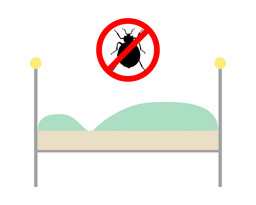Adult Bedbugs
 Adult bed bugs are about 3/16-inch long and reddish-brown, with oval, flattened bodies. They are sometimes mistaken for ticks or cockroaches. The immature's (nymphs) resemble the adults, but are smaller and lighter in color. Bed bugs do not fly, but can move rapidly over floors, walls, ceilings and other surfaces. Female bed bugs lay their eggs in secluded areas, depositing 1, 2 or more eggs per day and hundreds during a lifetime. The eggs are tiny, whitish, and hard to see on most surfaces without magnification (individual eggs are about the size of a dust speck). Their flat shape enables them to readily hide in cracks and crevices. The body becomes more elongate, swollen, and dark red after a blood meal. Bed bugs have a beaklike piercing-sucking mouthpart system. The adults have small, stubby, nonfunctional wing pads. Newly hatched nymphs are nearly colorless, becoming brownish as they mature. Nymphs have the general appearance of adults. Eggs are white and about 1/32 inch long.
Adult bed bugs are about 3/16-inch long and reddish-brown, with oval, flattened bodies. They are sometimes mistaken for ticks or cockroaches. The immature's (nymphs) resemble the adults, but are smaller and lighter in color. Bed bugs do not fly, but can move rapidly over floors, walls, ceilings and other surfaces. Female bed bugs lay their eggs in secluded areas, depositing 1, 2 or more eggs per day and hundreds during a lifetime. The eggs are tiny, whitish, and hard to see on most surfaces without magnification (individual eggs are about the size of a dust speck). Their flat shape enables them to readily hide in cracks and crevices. The body becomes more elongate, swollen, and dark red after a blood meal. Bed bugs have a beaklike piercing-sucking mouthpart system. The adults have small, stubby, nonfunctional wing pads. Newly hatched nymphs are nearly colorless, becoming brownish as they mature. Nymphs have the general appearance of adults. Eggs are white and about 1/32 inch long.
When first laid, the eggs are sticky, causing them to adhere to surfaces. Newly hatched nymphs are straw-colored and no bigger than a pinhead. As they grow, they molt (shed their skin) five times before reaching maturity. A blood meal is needed between each successive molt. Under favorable conditions (70-80°F), the bugs can complete development in as little as a month, producing three or more generations per year. Cooler temperatures or limited access to blood extends the development time. Bed bugs are resilient. Nymphs can survive months without feeding and the adults for more than a year. Infestations therefore are unlikely to diminish by leaving premises unoccupied. Although C. secularism prefers feeding on humans, it will also bite other warm-blooded animals, including dogs, cats, birds and rodents.

 Adults feed once a week on average but feed many times during their four-month or longer life span. Adults usually live for around 10 months, but can live for a year or more. In a home, where the environment is conducive to their reproduction (their ideal breeding temperature is between 21° to 28°C), bed bugs can breed year round. Adult bed bugs have been known to survive for as long as 550 days (over a year and a half!) without feeding.
Adults feed once a week on average but feed many times during their four-month or longer life span. Adults usually live for around 10 months, but can live for a year or more. In a home, where the environment is conducive to their reproduction (their ideal breeding temperature is between 21° to 28°C), bed bugs can breed year round. Adult bed bugs have been known to survive for as long as 550 days (over a year and a half!) without feeding.
Bed bugs grow by molting several times. Nymphs look very much like the adults, except they are smaller and not sexually mature. There are five nymph al molts, and each nymph must have a blood meal to be able to molt to the next stage. Adults feed once a week on average but feed many times during their four-month or longer life span.
International travel and commerce are thought to facilitate the spread of these insect hitchhikers, because eggs, young, and adult bed bugs are readily transported in luggage, clothing, bedding, and furniture. Bed bugs can infest airplanes, ships, trains, and buses. Bed bugs are most frequently found in dwellings with a high rate of occupant turnover, such as hotels, motels, hostels, dormitories, shelters, apartment complexes, tenements, and prisons. Such infestations usually are not a reflection of poor hygiene or bad house keep.
- Treating Bed Bug With chemicals [Last Updated On: September 19th, 2022] [Originally Added On: September 19th, 2022]
- Symptoms Picture Gallery [Last Updated On: September 20th, 2022] [Originally Added On: September 20th, 2022]
- Bed Bug Products [Last Updated On: September 21st, 2022] [Originally Added On: September 21st, 2022]
- Simplified Bed Bug Preparation [Last Updated On: September 22nd, 2022] [Originally Added On: September 22nd, 2022]
- Quality Pest Control Methods [Last Updated On: September 23rd, 2022] [Originally Added On: September 23rd, 2022]
- Pajamas Diminish Bed Bug Bites [Last Updated On: September 24th, 2022] [Originally Added On: September 24th, 2022]
- Bed Bug Picture Gallery [Last Updated On: September 25th, 2022] [Originally Added On: September 25th, 2022]
- Pesticides [Last Updated On: September 26th, 2022] [Originally Added On: September 26th, 2022]
- Male and Female Bed Bugs [Last Updated On: September 27th, 2022] [Originally Added On: September 27th, 2022]
- Affordable Bed Bug Registry Detection Method [Last Updated On: September 28th, 2022] [Originally Added On: September 28th, 2022]
- Introduction About Bed Bug [Last Updated On: September 29th, 2022] [Originally Added On: September 29th, 2022]
- Insect Bed Bug [Last Updated On: September 30th, 2022] [Originally Added On: September 30th, 2022]
- Welcome to Bed Bug Registry Database [Last Updated On: December 3rd, 2022] [Originally Added On: October 1st, 2022]
- How to Kill Bed Bugs [Last Updated On: October 2nd, 2022] [Originally Added On: October 2nd, 2022]
- How Bed Bug Bite [Last Updated On: October 3rd, 2022] [Originally Added On: October 3rd, 2022]
- Get Rid of Bed Bugs [Last Updated On: October 4th, 2022] [Originally Added On: October 4th, 2022]
- DDT for Bed Bugs [Last Updated On: October 5th, 2022] [Originally Added On: October 5th, 2022]
- Control Bed Bugs [Last Updated On: October 6th, 2022] [Originally Added On: October 6th, 2022]
- Contact Us [Last Updated On: October 7th, 2022] [Originally Added On: October 7th, 2022]
- Box Spring Treatment [Last Updated On: October 8th, 2022] [Originally Added On: October 8th, 2022]
- Bed Bug Products [Last Updated On: October 9th, 2022] [Originally Added On: October 9th, 2022]
- Bed Bug Products [Last Updated On: October 10th, 2022] [Originally Added On: October 10th, 2022]
- Bed Bug Wall or Baseboard [Last Updated On: October 11th, 2022] [Originally Added On: October 11th, 2022]
- Bed Bug Videos [Last Updated On: December 5th, 2022] [Originally Added On: October 12th, 2022]
- Bed Bug Treatment Synergy [Last Updated On: October 13th, 2022] [Originally Added On: October 13th, 2022]
- Bed Bug Treatment and Removal, How it is done [Last Updated On: October 14th, 2022] [Originally Added On: October 14th, 2022]
- Bed Bug Transmit Disease [Last Updated On: October 15th, 2022] [Originally Added On: October 15th, 2022]
- Bed Bug Tape [Last Updated On: October 16th, 2022] [Originally Added On: October 16th, 2022]
- Bed Bug Products [Last Updated On: October 17th, 2022] [Originally Added On: October 17th, 2022]
- Bed Bug Sniffing Dogs [Last Updated On: October 18th, 2022] [Originally Added On: October 18th, 2022]
- Bed Bug Spray - Non Toxic [Last Updated On: October 19th, 2022] [Originally Added On: October 19th, 2022]
- Bedbug Species [Last Updated On: October 20th, 2022] [Originally Added On: October 20th, 2022]
- Bed Bug Products [Last Updated On: October 21st, 2022] [Originally Added On: October 21st, 2022]
- Bed Bug Products [Last Updated On: October 22nd, 2022] [Originally Added On: October 22nd, 2022]
- Bed Bug Repellent [Last Updated On: October 24th, 2022] [Originally Added On: October 24th, 2022]
- Bed Bug Products [Last Updated On: October 25th, 2022] [Originally Added On: October 25th, 2022]
- Bed Bug Products [Last Updated On: October 26th, 2022] [Originally Added On: October 26th, 2022]
- Bed Bug Products [Last Updated On: October 27th, 2022] [Originally Added On: October 27th, 2022]
- Bed Bug Pillow Case Encasement Covers [Last Updated On: October 29th, 2022] [Originally Added On: October 29th, 2022]
- Bed Bug Products [Last Updated On: October 30th, 2022] [Originally Added On: October 30th, 2022]
- Bed Bug Network [Last Updated On: October 31st, 2022] [Originally Added On: October 31st, 2022]
- Bed Bug Molting [Last Updated On: November 1st, 2022] [Originally Added On: November 1st, 2022]
- Bed Bug Mattress Encasement Protector Covers [Last Updated On: November 2nd, 2022] [Originally Added On: November 2nd, 2022]
- Bed Bug Look Like [Last Updated On: November 3rd, 2022] [Originally Added On: November 3rd, 2022]
- Advanced Bed Bug Preparation [Last Updated On: November 4th, 2022] [Originally Added On: November 4th, 2022]
- Bed Bug Wall or Baseboard [Last Updated On: November 5th, 2022] [Originally Added On: November 5th, 2022]
- Bedbug Legislation [Last Updated On: November 6th, 2022] [Originally Added On: November 6th, 2022]
- Bed bug Knowledge [Last Updated On: November 7th, 2022] [Originally Added On: November 7th, 2022]
- Bed Bug Products [Last Updated On: November 8th, 2022] [Originally Added On: November 8th, 2022]
- Bedbug in Hotel [Last Updated On: November 9th, 2022] [Originally Added On: November 9th, 2022]
- Bedbuig in Clothes, Fabrics [Last Updated On: November 11th, 2022] [Originally Added On: November 11th, 2022]
- Bedbug History [Last Updated On: November 12th, 2022] [Originally Added On: November 12th, 2022]
- Bedbug Hiding PLaces [Last Updated On: November 13th, 2022] [Originally Added On: November 13th, 2022]
- Bed Bug Nesting Location [Last Updated On: November 14th, 2022] [Originally Added On: November 14th, 2022]
- Bed Bug Products [Last Updated On: November 15th, 2022] [Originally Added On: November 15th, 2022]
- Bedbug Feedings [Last Updated On: November 16th, 2022] [Originally Added On: November 16th, 2022]
- Bed Bug Products [Last Updated On: November 17th, 2022] [Originally Added On: November 17th, 2022]
- Bedbug Epidemic [Last Updated On: December 3rd, 2022] [Originally Added On: November 18th, 2022]
- Bed Bug Eggs and Nymphs [Last Updated On: November 19th, 2022] [Originally Added On: November 19th, 2022]
- Bed Bug Distribute [Last Updated On: November 20th, 2022] [Originally Added On: November 20th, 2022]
- Bed Bug Discrimination [Last Updated On: November 21st, 2022] [Originally Added On: November 21st, 2022]
- Bed Bug Products [Last Updated On: November 22nd, 2022] [Originally Added On: November 22nd, 2022]
- Bed Bug Colony [Last Updated On: November 23rd, 2022] [Originally Added On: November 23rd, 2022]
- Bed Bug Products [Last Updated On: November 24th, 2022] [Originally Added On: November 24th, 2022]
- Bed Bug Products [Last Updated On: November 25th, 2022] [Originally Added On: November 25th, 2022]
- Bed Bug Box Spring Encasement Covers [Last Updated On: November 26th, 2022] [Originally Added On: November 26th, 2022]
- Bed Bug Bites Pictures [Last Updated On: November 27th, 2022] [Originally Added On: November 27th, 2022]
- Bedbug Bites [Last Updated On: December 3rd, 2022] [Originally Added On: November 28th, 2022]
- Bed Bug Products [Last Updated On: November 29th, 2022] [Originally Added On: November 29th, 2022]
- Bed Bug Products [Last Updated On: December 3rd, 2022] [Originally Added On: November 30th, 2022]
- Allergy Sentry Box Spring Encasement [Last Updated On: December 1st, 2022] [Originally Added On: December 1st, 2022]
- Affordable Bed Bug Detection Method [Last Updated On: December 5th, 2022] [Originally Added On: December 2nd, 2022]
- Advanced Bed Bug Preparation [Last Updated On: December 3rd, 2022] [Originally Added On: December 3rd, 2022]

